Coal has historically been a major energy source in Alberta, contributing significantly to electricity generation. However, there has been a shift towards cleaner energy sources in recent years, driven by environmental concerns and government policies. Alberta is gradually reducing its reliance on coal in favour of natural gas and renewable energy sources.

Deregulated services refer to industries or sectors where government regulations on pricing, entry, and operation have been loosened or removed. This typically allows for increased competition among businesses within the sector. Deregulation aims to enhance efficiency, lower consumer prices, and stimulate innovation by freeing companies from bureaucratic restrictions. Common examples of deregulated services include telecommunications, transportation, energy, and finance. In a deregulated market, companies have more freedom to set prices based on market demand and competitive forces, rather than being bound by government-imposed rates or controls. However, deregulation also poses risks, such as potential market abuses or monopolistic practices, which regulatory bodies must monitor and address to maintain fair competition and protect consumers.
Electricity reaches your home through a complex distribution system starting at power plants generating electricity. From there, electricity travels over high-voltage transmission lines that carry it across long distances to substations where the voltage is reduced. These substations then distribute electricity through lower-voltage distribution lines that extend into neighbourhoods and communities. Transformers lower the voltage to a level that can be used in your home, typically stepping it down to the standard household voltage. Finally, the electricity travels through the service line to your home’s electrical panel, from where it is distributed to outlets and appliances. This network ensures that electricity generated miles away lights up your home and powers your devices.
Electricity can travel through air under certain conditions, primarily when the electrical potential difference (voltage) between two points is high enough to ionize the air and create a conductive path. This phenomenon is seen in nature as lightning, where a high voltage difference between clouds and the ground, or within clouds, causes electricity to discharge through the air. In man-made systems, sparking or arcing can occur when high voltage causes the air between conductors to become ionized. However, air is generally an insulator, and under normal conditions, it resists the flow of electricity. Electrical engineers use insulating materials and careful design to prevent unintended arcing in electrical equipment. Thus, while electricity can technically travel through air, it requires conditions that overcome air’s natural resistance to electrical flow.
To choose an energy provider, start by assessing your energy needs and priorities, considering factors like consumption, renewable energy options, and pricing structures. Research available providers in your area, reading customer reviews and recommendations to gauge their reputation. Compare rates, contract terms, and any renewable energy options that align with your preferences. Assess customer service quality and look for additional services or benefits, such as energy efficiency audits. Understand billing and payment methods and carefully review contract terms and fees. Seek recommendations from others and contact providers directly to ask questions. Once you’ve gathered this information, make an informed choice that suits your needs and preferences while keeping an eye on potential switching procedures if you’re changing providers.
Electricity can travel through water because water is a conductor, especially when it contains impurities or dissolved salts that provide ions to carry electrical charges. This is why it’s dangerous to operate electrical devices near water or to touch water that may be in contact with electricity. Pure water without impurities (distilled water) is a much poorer conductor of electricity because it lacks the ions necessary for conducting electric current. However, most water we encounter in our daily lives, including tap water and natural water bodies, has enough dissolved substances to conduct electricity. Safety measures, such as using Ground Fault Circuit Interrupters (GFCIs) in areas near water, are important to prevent electrical accidents. Electrical systems are designed with this conductivity in mind to ensure safety and prevent electrical hazards.
Your electricity charge consists of two parts:
Your electricity usage is measured by your meter. Your meter number is specific to your meter. The usage charges account for the actual amount of energy you used during the billing timeframe.
Delivery charges are 100% regulated by the government and are solely dependent on where in the province your site is located. Changing providers does not alter your delivery charges as changing providers does not change the distribution network your site is connected to. Visit our blog to learn more about what fees are included in your bill.
Links